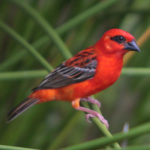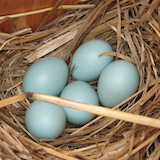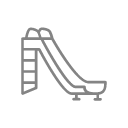6.32: Putting It Together: ¿Qué tiempo hace hoy?
- Page ID
- 50190
Click on each link below for a review summary to help you complete the assignments and prepare for the quiz to demonstrate your mastery of the objectives.
[reveal-answer q=”93300″]Describe the weather[/reveal-answer]
[hidden-answer a=”93300″]
Most weather expressions in Spanish are built with hace, such as:
There are some weather expressions that are different and are not built with hace, such as:
[/hidden-answer]
[reveal-answer q=”193657″]Describe things using the correct position, gender and number of adjectives[/reveal-answer]
[hidden-answer a=”193657″]
If the noun is masculine and singular, the adjective that describes the noun will also be masculine and singular:
![]() el chico generoso (the generous boy)
el chico generoso (the generous boy)
If the noun is feminine and singular, the adjective that describes the noun will also be feminine and singular:
![]() la chica generosa (the generous girl)
la chica generosa (the generous girl)
If the noun is masculine and plural, the adjective that describes the noun will also be masculine and singular:
![]() los chicos generosos (the generous boys)
los chicos generosos (the generous boys)
If the noun is feminine and plural, the adjective that describes the noun will also be feminine and plural:
![]() las chicas generosas (the generous girls)
las chicas generosas (the generous girls)
If an adjective ends in -o for the masculine form, it generally will also have a feminine form (generoso / generosa as shown in the examples). If a masculine singular adjective ends in a consonant or a vowel other than -o (most commonly -e), such as importante, it does not change for gender but it will change for number:
![]() el documento importante (the important document)
el documento importante (the important document)
The plurals of adjectives are formed in the same way that you learned in previous lessons for nouns. Add an -s if the word ends in a vowel; add an -es if the word ends in a consonant:
![]() el marcador verde (the green marker)
el marcador verde (the green marker)
![]() los marcadores verdes (the green markers)
los marcadores verdes (the green markers)
[/hidden-answer]
[reveal-answer q=”933465″]Describe the color of things[/reveal-answer]
[hidden-answer a=”933465″]


















 Adjetivos indefinidos
Adjetivos indefinidos
![]() algún,
algún, ![]() alguno (some)
alguno (some)![]() ningún,
ningún, ![]() ninguno (none, not any)
ninguno (none, not any)![]() mucho (many, a lot of)
mucho (many, a lot of)![]() cada (each)
cada (each)
 Un adverbio (muy) útil (a [very] useful adverb)
Un adverbio (muy) útil (a [very] useful adverb)
[/hidden-answer]
[reveal-answer q=”581572″]Recognize and describe articles of clothing[/reveal-answer]
[hidden-answer a=”581572″]

la bufanda

la gorra

el impermeable

el pijama

el suéter
 Un verbo útil (a useful verb):
Un verbo útil (a useful verb):
![]() Llevar (to wear; also means to carry and to bring)
Llevar (to wear; also means to carry and to bring)
[/hidden-answer]
[reveal-answer q=”58408″]Form numbers past 100[/reveal-answer]
[hidden-answer a=”58408″]
We’ve already learned to count to 100:
…![]() 98 noventa y ocho
98 noventa y ocho![]() 99 noventa y nueve
99 noventa y nueve![]() 100 cien
100 cien
Note how the pattern changes slightly: we’re not using y anymore. That’s just to separate the tens place from the ones place. So “one hundred one,” not “one hundred and one.”
![]() 102 ciento dos
102 ciento dos
![]() 110 ciento diez
110 ciento diez
![]() 120 ciento veinte
120 ciento veinte
![]() 134 ciento treinta y cuatro (the y is separating the tens place from the ones place)
134 ciento treinta y cuatro (the y is separating the tens place from the ones place)
![]() 200 doscientos
200 doscientos![]() 300 trescientos
300 trescientos![]() 400 cuatrocientos
400 cuatrocientos![]() 500 quinientos
500 quinientos![]() 600 seiscientos
600 seiscientos![]() 700 setecientos
700 setecientos![]() 800 ochocientos
800 ochocientos![]() 900 novecientos
900 novecientos
![]() 1000 mil (Note: Not “un mil,” just “mil“)
1000 mil (Note: Not “un mil,” just “mil“)
![]() 1500 mil quinientos
1500 mil quinientos![]() 2000 dos mil
2000 dos mil![]() 4000 cuatro mil
4000 cuatro mil![]() 100.000 cien mil
100.000 cien mil
1.000.000 un millón
11.000.000 once millones
Note: you must use mil to talk about years (this is different from the English way of splitting years into two-digit clusters)
- (in)
 1950 = (en) mil novecientos cincuenta
1950 = (en) mil novecientos cincuenta - (in)
 1821 = (en) mil ochocientos veintiuno
1821 = (en) mil ochocientos veintiuno - 2019 = dos mil diecinueve
Another note: Most Spanish-speaking countries use a comma to mark the decimal point, and a period or dot to mark the thousands position in long numbers. This is beginning to change somewhat as the English way of punctuating numbers is spreading via the Internet. So you’ll need to be careful not to mistake decimals for thousands!
![]() $123.456,78 = ciento veintitrés mil cuatrocientos cincuenta y seis dólares con setenta y ocho centavos
$123.456,78 = ciento veintitrés mil cuatrocientos cincuenta y seis dólares con setenta y ocho centavos
[/hidden-answer]
[reveal-answer q=”451770″]Use verbs in the present tense that end in -er & -ir to describe everyday activities[/reveal-answer]
[hidden-answer a=”451770″]
-er verbs
-ir verbs
-
 abrir (to open)
abrir (to open)
-
 compartir (to share)
compartir (to share)
-
 cumplir (to complete)
cumplir (to complete)
-
 decidir (to decide)
decidir (to decide)
-
 describir (to describe)
describir (to describe)
-
 escribir (to write)
escribir (to write)
-
 recibir (to receive)
recibir (to receive)
-
 vivir (to live)
vivir (to live)
These verbs are conjugated similarly to –ar verbs, but with different characteristic vowels. In order to form the present tense—just as you did with –ar verbs—remove the –er or –ir ending from the infinitive, and then add the following endings to the stem:
| (stem: beb) | |
| singular | plural |
| vivir (to live) | |
| (stem: viv) | |
| singular | plural |
Notice that the only difference in the endings of -er and -ir verbs in the present tense occurs in the nosotros and vosotros forms.
[/hidden-answer]
[reveal-answer q=”517414″]Learn about the Catholic pilgrimage tradition through northern Spain to Santiago de Compostela[/reveal-answer]
[hidden-answer a=”517414″]See the Cultura section in the Study Plan for these activities.[/hidden-answer]
Contribute!
- RGB color wheel24. Authored by: Lu00e1szlu00f3 Nu00e9meth. Provided by: Wikimedia Commons. Located at: commons.wikimedia.org/wiki/File:RGB_color_wheel_24.svg. License: CC0: No Rights Reserved
- Putting It Together: u00bfQuu00e9 tiempo hace hoy?. Authored by: SUNY Oneonta with Lumen Learning. License: CC BY: Attribution


















































